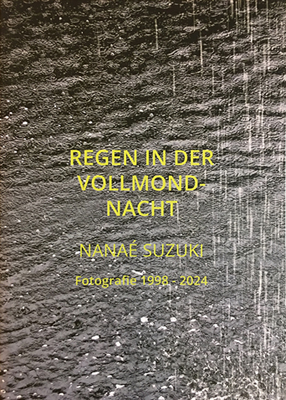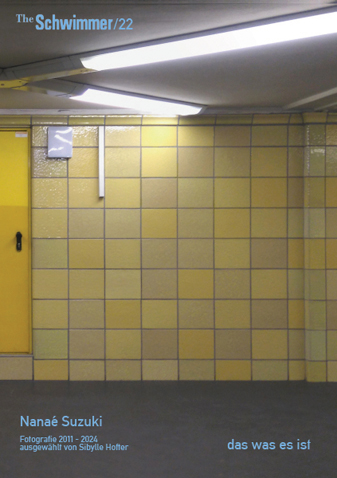| Biography | |
| Born in Kanazawa, Japan, 1947 1969-71 studied at the Tokyo University of Arts 1977 moved to Europe lives and works in Berlin since 1981 |
|
| Solo and Duo Exhibitions (Selected) | |
| 1993 | Fragile Gesellschaft, Berlin |
| 1995 | Merve Verlag, Berlin |
| 1997 | Art Space Niji, Kyoto |
| 1998 | Galerie von der Milwe, Aachen Galerie Rainer Borgemeister, Berlin (with Friederike Feldmann) |
| 2001 | Art Space Niji, Kyoto Haus am Lützowplatz, Berlin (with Folke Hanfeld) |
| 2002 | Galerie Nord, Berlin |
| 2003 | Japan Foundationt, Köln (with Eva-Maria Schön) Galerie von der Milwe, Aachen (with Nanne Meyer) |
| 2004 | Stella A., Berlin (with Eva-Maria Schön) Art Space Niji, Kyoto |
| 2007 | Stella A., Berlin Art Space Niji, Kyoto |
| 2009 | Galerie edition.SABA, Berlin Stella A., Berlin Kunsthalle, Ettenheim |
| 2010 | K-Salon, Berlin (with Hanna Sjöberg) |
| 2011 | Anhaltische Gemädegalerie, Dessau |
| 2012 | Fremdenhaus im Georgienpark, Dessau Art Space Niji, Kyoto |
| 2013 | Stella A., Berlin |
| 2015 | Japanisch-Deutsches Zentrum Berlin (with Eva-Maria Schön) |
| 2017 | Fremdenhaus beim Schloss Georgium, Dessau |
| 2019 | Stella A., Berlin |
| 2020 | Museum der Unerhörten Dinge, Berlin |
| 2022 | Galerie Stella A., Berlin |
| 2025 | Bürgerbüro Sven Meyer, Berlin Forum Analoge Photographie |
| Group Exhibitions (Selected) | |
| 1985 | Quergalerie im Eisstadion, Berlin |
| 1986 | Sip.Berlin, Kunstquartier Ackerstraße, Berlin Bericht uit Berlijn/Report from Berlin, Apollohuis, Eindhoven |
| 1988 | Vom alten Westen zum Kulturforum/Forum, Berlin |
| 1989 | Space Pilot, weltbekannt e.V., Hamburg |
| 1992 | Ortszeit, Künstlerhaus Plüschow |
| 1996 | Panoptik, Berlin |
| 1998 | Umzug ins Offene/Moving into the Openness, Hamburg |
| 1999 | Perspektíva/Perspective, Mücsarnok / Kunsthalle Budapest La Belle Jardinière, Wiepersdorf |
| 2000 | Heimat Kunst, Haus der Kulturen der Welt, Berlin |
| 2001 | Bibliothek im Schloßpark, Steinhöfel |
| 2003 | Das Atmen der Stadt/The Breathing of the City, Haus am Waldsee, Berlin Thema Stadt, Gelerie Netuschil, Darmstadt Changing Channels, London Biennale, Berlin |
| 2004 | The 1st International Biennale of Art in Lodz |
| 2006 | Verstecke, Neues Kunsthaus Ahrenshoop Garten Georgium, Dessau Friedrich Gilly in Steinhöfel |
| 2009 | Noorderlicht Photofestival, Groningen |
| 2010 | Villa Streccius, Landau |
| 2014 | Daily Memories, Kunstmuseum Kloster unser lieben Frauen Magdeburg |
| 2016 | *****. Stella A., Berlin |
| 2017 | Innenohr, Projektraum, Kunstquartier Bethanien, Berlin |
| 2018 | ENTWEDER UND, GEHAG Forum, Berlin BERLINZULAGE, Künstlerhaus Bethanien, Berlin |
| 2019 | ÜBERLANDLEITEN, Steinhöfel / Familyslogan, FREEHOME, Berlin Think Small, Stella A., Berlin |
| 2020 | Marianne Werefkin-Preis 2020, Haus am Kleistpark, Berlin |
| 2021 | Intuition. Hommage à Beuys, Stella A, Berlin Endless Summer, Kleiner von Wiese, Berlin |
| 2024 | LIGATUREN Kunst im Kontext in der Literatur, Literaturhaus Halle Abschied - Farewell, Stella A., Berlin |
| 2025 |
States of Uncertain Domesticities, Haus Kunst Mitte, Berlin States of Uncertain Domesticities, House of Arts, Brno |
| Grants | |
| 1995 | Working grant from the City of Berlin |
| 1997-2000 | Studio grant from the City of Berlin |
| 2009 | Artist in Residence Künstlerhaus Edenkoben |
| 2020 | NEUSTART KULTUR |
| 2021 | Working Grant of the Stiftung Kunstfonds Bonn |
| 2022 | Maartha-Laugs-Grant of the Stiftung Kunstfonds Bonn Recherchestipendium from the city of Berlin |
Books and Editions

Nanaé Suzuki Fotografie 1998 - 2024
Text: Eva Meyer
Pluraal Verlag, Berlin, 2024

Nanaé Suzuki Fotografie 2011 - 2024
Selection and layout by Sibylle Hofter
The Schwimmer / 22, Berlin 2024

13 postcards in a carton box
Pluraal Verlag, Berlin, 2022

Text: Kayo Adachi-Rabe
English / German
Pluraal Verlag, Berlin, 2022

13 postcards in a carton box, 2021

with Cecile Rossant
Pluraal Verlag, Berlin, 2021

10 postcards in a carton box
Pluraal Verlag, Berlin, 2020

PAIRS AND THEIR SCHADOWS Verlag Art In Flow
Berlin 2018

Nana é Suzuki 2004
Auflage 100

with Eva-Maria Schön
Japanisches Kulturinstitut Köln, Köln 2003

Haus am Lützowplatz, Berlin 2001

Weidle Verlag, Bonn 1999

Edition mit 20 Postkarten, Auflage 100
Edition Giannozzo, Berlin 1982
Catalogues of group exhibitions BERLINZULAGE
daily memories gehen blühen fließen VERSTECKE inside – outside Umzug ins Offene · Vier Versuche über den Raum Heimat Kunst Perspektíva Perspective HET APOLLOHUIS 1985-1990 ORTSZEIT Space Pilot 07 Freiluft Künstler auf einer Geschichtsdeponie Wirken und Wirkung Sip.Berlin Quergalerie im Eisstadion
|
|
|
Reviews (selected)
Thomas Altmann, „Von der Tiefe der Oberfläche“ Brigitte Schmalenberg, „Auf die innere Haltung kommt es an“ Ronald Berg, „Aus den Fugen“ Beate Eickhoff, „Spachtelstriche, von links nach rechts“ Hanns Zischler, „Das osmotische Gesetz der Physiognomie“ Marion Thielebein, „Kopfstandperspektiven sind nicht etwa ein Spaßfaktor“ Katja Reissner, „Sehenswürdigkeit als Bildwunder“
|
|
Texts on Nanaé Suzuki |
|
Giddiness Katrin Bettina Müller |
|
The Japanese artist Nanaé Suzuki (b. 1947) is concerned with transforming sight and memory and since 1981 has been living in Berlin, where she is known mainly for her surreal images of architecture. Between two fingers she holds the world. The round cut-outs of postcards, which she has photographed spinning between forefinger and thumb, suggest a world spinning too fast to be seen clearly, since postcards show parts of it travelled to. Blurred by the spinning, the flat image resembles a soap-bubble reflecting its surroundings dimly, like sights in Berlin where Nanaé Suzuki has been living since 1981. Nanaé Suzuki was born in 1947 in Kanazawa, Japan, studied from 1966 to 1971 at the State Art School in Tokyo, then came to Berlin in 1981. In 1995 she got a work-grant, and in 1997 an atelier-grant from the Senate of Berlin. Wall pictures were created in 1995 in Berlin, and in 1997 in Osaka.
| |
Working on the Analog Folke Hanfeld |
|
If the search for lost time is best described through literature, then the most fitting medium for the search for lost places is photography. Every photograph carries within it the longing to be present in a certain place at a certain time. Even scenes of horror and pictures of hell fulfill the desire for unlimited testimony. There are places and points in time that are bound together with emotions, which are sought out again and again. Clearly Nanaé Suzuki has gone to find such places, but with which technical device does she approach them? The mechanism of a photo camera usually consists of leading an outward phenomenon into a closable space and capturing it there on the celluloid band. In contrast, it seems that a photograph springing from Nanaé Suzuki’s camera shows a scene that takes place on the inside of the camera rather than in the world beyond the lens. Or is the film lit entirely by a fantasy or memory that bores through the eye of the photographer and the searchers into the darkness of the (reflex) camera? Subjective photography in its extreme form? That which can be recognized in the images is multi-layered and ambiguous. At first glance and from a distance, their character and choice of colors recall the medium of painting. The space one catches sight of is crooked, folded, labyrinthine, and has relieved itself completely of its three-dimensional coordination and its central perspective. The gaze glides through light-filled spheres over colorful structures and occasionally hits upon concrete objects, figures and places that emerge out of the image ground – sometimes veiled to the limits of their recognizable-ness or anamorphotically contorted. A universe gives birth to unpredictable encounters and preserves a moment; an image comes into being. The production of the photographs is such that objects, picture cutouts, optical elements and additional lenses are densely arranged in front of the camera. The scene is then recorded under daylight or sunlight using analog technology and with that, the photo is finished – not a single additional form of manipulation such as double exposure, montage, detail enlargement, etc., is employed. Finally, the object of presentation is a print optimally graded and with the highest color fidelity.
|